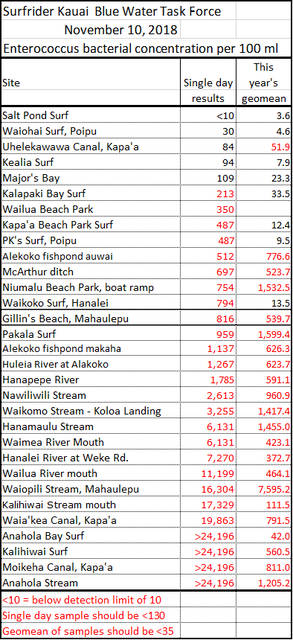LIHUE — Kauai is flushing out more bacteria through rivers and streams than it has in the last decade, according to test results from the island’s Surfrider Blue Water Task Force.
Department of Health’s Clean Water Branch has five brown water advisories out surrounding Kauai — which alert the public of potential water pollution from runoff.
Some of those advisories have been active for months and are still listed on the DOH website, like the brown water advisory issued for North Kauai on Aug. 31, in an area where heavy rains once again sent runoff into the rivers and ocean.
“Heavy rains all around the island on Friday and Saturday morning caused all of the rivers and streams to flood and pour out contaminated water,” said Carl Berg, of Surfrider Kauai’s BWTF. “Rain so heavy that the Hanalei road was closed and we had to forgo most North Shore sampling.”
Monthly, volunteers with BWTF sample a specific set of areas and add other test sites as needed, depending on rain events and other activities.
The team sampled throughout the island on Saturday with only five of the 31 samples returning numbers below the state’s threshold of 130 parts of bacteria per 100 mL.
Those areas include Salt Pond’s surf, Waiohai surf in Poipu, Uhelekawawa Canal in Kapaa, Kealia surf, and Major’s Bay.
Equipment can only detect up to 24,196 parts of bacteria per 100 mL, and results from four places reached or surpassed that number — Anahola Bay surf, Kalihiwai surf, Moikeha Canal in Kapaa and Anahola Stream.
Researchers pointed out river water flowed out into surf breaks at Kalihiwai, Anahola, Kealia, Waikoko giving them high bacteria counts.
“(Saturday’s) values, combined with those from flooding earlier in the year, have brought our mean values up higher than we have seen in the past 10 years,” Berg said.
Several high rainfall events have sent water from the mountains to the sea since April, but Berg said, “chronically polluted places did not get cleaned out.”
DOH’s brown water advisories are for Anini, Wailua Bay, Koloa Landing, Ha’ena Beach and the North Shore of Kauai — the entity tests in different places than Surfrider does.
Cesspool pathogens, overflowing manholes and other runoff are responsible for the high bacteria counts and DOH advises the public to stay out of streams or beaches that are contaminated by stormwater.
••• Jessica Else, environment reporter, can be reached at 245-0452 or at jelse@thegardenisland.com



Yawn…..How long has Carl Berg been crying, the sky is falling, the sky is falling?
Yeah, “volunteer” testing by an activist organization.
“Hey guys, it just rained. Let’s go test – I know this sweet spot where there’s an eddy and the water collects. We’ll get plenty counts there.”
Compostible toilets are the future & it doesn’t make sense NOT to allow, or better yet, require them in all new construction…resorts included, once the technology makes them practical.
We value the water quality testing that the DOH & Surfrider continually provide & appreciate being informed. It is truly necessary as the population goes up & cesspools & septic systems remain in use. Sewage capacity &/or deterioration of the current systems make it imperative that we know what we are either swimming in or…drinking.
Mahalo for your services DOH & Surfrider!